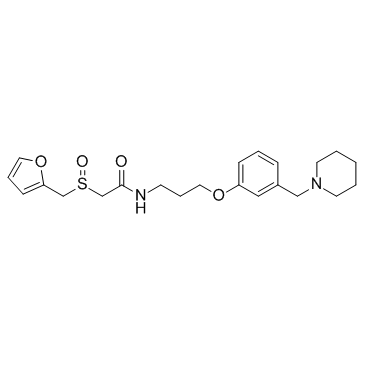| Description |
FRG-8701 is a new Histamine H2-receptor antagonist with an IC50 of ranging from 0.25 to 0.43 μM.
|
| Related Catalog |
|
| Target |
IC50: 0.25 to 0.43 μM (Histamine H2-receptor)[1]
|
| In Vitro |
Positive chronotropic response to histamine at 10-5 M is dose dependently inhibited by FRG8701 (FRG-8701) famotidine or cimetidine; and the IC50 values of FRG8701, famotidine and cimetidine are 3.3, 3.0 and 108.6 (×10-7M), respectively.The inhibitory potency of FRG8701 is almost the same as that of famotidine and approximately 33 times greater than that of cimetidine[1].
|
| In Vivo |
In the pylorus-ligated (4 hr) rats, each drug, given intraduodenally, dose-dependently inhibits the total acid output. FRG8701 at 10 or 30 mg/kg, given orally or intraperitoneally, significantly prevent the formation of the gastric mucosal lesions induced by 0.4 N HCI+50% ethanol (HCI•ethanol). Other necrotizing agents-induced gastric lesions are also inhibited by treatment of FRG8701. The oral ED50 values against the lesions range from 1.1 to 9.4 mg/kg. FRG8701, given orally, dose-dependently prevents the development of gastric lesions induced by stress and indomethacin. Duodenal ulcer induced by mepirizole is also inhibited with FRG8701. The ED50 values of FRG8701 for each ulcer model range from 1.7 to 6.9 mg/kg[1].
|
| Cell Assay |
In this study, male guinea pigs weighing 250-350 g are used. The hearts are excised from animals and right atria are dissected carefully. Atria are suspended in Krebs Henseleit (KH) solution, maintained at 32°C and aerated with 95% O2 and 5% CO2. The tissue is attached with an initial load of 1 g to an isometric transducer and allowed to stabilize for 60 min before histamine application. The histamine response is repeated 10 min after the tissue is incubated with various concentrations of FRG8701 or reference H2-antagonist[1].
|
| Animal Admin |
Gastric mucosal lesions are produced using various kinds of necrotizing agents. One hour after necrotizing agent treatment, the animals are sacrificed. The stomach is removed and in flated by injecting 10 mL of 2% formalin. Subsequently, the stomach is incised along the curvature and examined for macroscopic hemorrhagic damages under a dissecting microscope (×10). In addition, FRG8701 is given intraperitoneally before HCI-ethanol treatment[1].
|
| References |
[1]. Shibata M,et al. Effects of FRG-8701 on gastric acid secretion, gastric mucosal lesions by necrotizing agents and experimental gastric or duodenal ulcer in rats. Jpn J Pharmacol. 1990 Nov;54(3):277-85.
|
